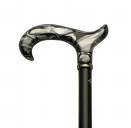
Some writers are known for their style. You know their writing as theirs when you read or hear it because the choices they make in terms of language are distinctive and unique to them. On one end of the style spectrum, you’ve got voicey writers. Think of Barry Hannah who, in describing a dream he once had (of a bar and after giving up liquor), writes, “pickled eggs in a massive jar at the end of a dark-wooded gold-wrapped bar, immense.” A writer with a more transparent style of writing might have described this dream differently, “there was a jar of eggs at the end of the bar,” for example. But Hannah is a writer who is interested in the way the sounds of words in combination can effect their meaning. Lots of folks cite writers like Hemingway and Hempel as standing firmly at the transparent end of the style spectrum. (You’ll see an excerpt from Hempel at the bottom.)
Both voicey and transparent styles have their merits, as do styles that land somewhere in the middle. And different styles serve different purposes. But how do most writers come upon their styles? Is it a choice? Something you’re born with? If you asked Barry Hannah how he found his style, I think he’d tell you it had something to do with learning to pay attention to the story he wanted to tell and then locating the right voice to tell it in. Read about it in his essay “Mr. Brain, He Want A Song.” It’s in a book of essays about writing called The Eleventh Draft, one which I highly recommend to you.
Finding your style might have a good deal to do with finding your voice, which is often regarded as a sort of essence of self, communicated through the writing. But it’s probably important to note that your style might shift considerably between projects and change over time. Writers make many stylistic changes, but the truth is likely that we can never quite escape ourselves. Even if we make serious changes in our approaches to stories, signs of our selves will remain.
What’s your style?
Maybe you feel you’ve already found your style, or maybe you’re still hunting it down. Either way, trying on different styles is a good way of sussing out some margins for yourself. Let’s do a little of that today, shall we? Spend a few minutes re-writing the following passage from Amy Hempel’s story “In A Tub,” using a very very voicey voice. Then, using your re-write as the template, re-write the passage using a different voice. You may add any details or ruminations that you like, but let’s keep it in first-person POV and stick with the basic scenario of a character standing on a deck.
At the back of my house I can stand in the light from the sliding glass door and look out onto the deck. The deck is planted with marguerites and succulents in red clay pots. One of the pots is empty. It is shallow and broad, and filled with water like a birdbath.


No comments:
Post a Comment